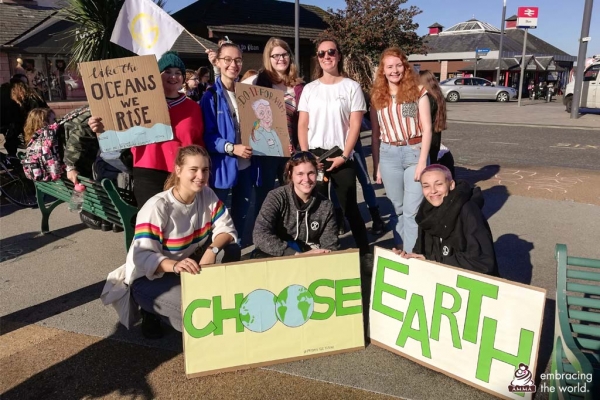As the UN Climate Change Conference (COP25) begins this week, UN Secretary General António Guterres stated that the next 12 months are crucial.
"It is essential that we secure more ambitious national commitments - particularly from the main emitters - to immediately start reducing greenhouse gas emissions at a pace consistent to reaching carbon neutrality by 2050,” he explained.
"We simply have to stop digging and drilling and take advantage of the vast possibilities offered by renewable energy and nature-based solutions."
AYUDH, our global youth movement, has been focusing on ways to address these concerns - from tree planting initiatives to trash cleanups. In September, a group of marine science students with AYUDH’s chapter in a small town on the west coast of Scotland decided to also take to the streets in peaceful protest.
Their commitment that day was to focus on kindness as an essential pathway to address the climate crisis. Jule, among those who took part, shares her experience:
I am an undergraduate student at the Scottish Association for Marine Sciences in Oban, Scotland. My story is a little different from many other acts of kindness in that it is not an act carried out directly to a certain person, target group, or organisation. It is, you could say, an indirect act that aims to have an impact in the long run; an impact that might not be visible at first glance but will show itself quite clearly once you start taking a closer look.
On 20th September 2019, I joined a strike in Oban that was part of a global climate strike organized by Fridays for Future. Students all over the world stay away from school on Fridays to take to the streets and protest their governments’ lack of effective climate protection policies and measures.
At around nine o’clock on that perfect autumn day with crisp blue skies and sunshine, people started gathering at Oban station square. Since Oban with its roughly 8000 citizens is not exactly what you would call a large town, expectations for the participation turn-out were not too high. But as more and more people came in with their cardboard signs, the anticipation was rising rapidly.
I was waiting alongside a couple of fellow university students and teachers. The square was filling with people of all ages - parents with small children, senior citizens, and, at around 9:30, an abundance of young students from the local Oban High School.
Soon after the students had arrived, we started walking through the centre of town, displaying our beautifully crafted signs as well as trying out some songs and chants. Our protest march split up along the way to maximize our visibility, and then joined again to gather at our destination, a parking lot at the other end of town.
We stayed there for about 20 minutes, enjoyed each other’s company and the fulfilment that comes after a protest that was - even though not the biggest one in the largest town - without a doubt very successful.
Personally, I think the impact this action had is bigger than it might seem at first glance. Many would say protesting in a town with such a small population is a pointless effort. To me on the other hand, it showed very clearly how concerned, how dedicated and how forward-thinking the people of Oban are.
The strike was an action that contributed to the local life and cultural events and a signal to all citizens and visitors saying, “We care about this place and the world we live in. We want to participate and make a difference; we want to make our home more colorful and vibrant.”
On a larger scale, as I mentioned before, the strike was part of a global action. Altogether, it is estimated that as many as 4 million people from more than 150 countries took part that day. This showed world governments that the people they represent are organizing, that they are aware of their rights and responsibilities in democratic societies, that they are watching their every step and will not let politicians continue the way they did before.
Coming back to the topic of kindness, though. Both points mentioned above are an expression of probably the most important thing we tried to convey. Even though our strike was more an act of democratic participation than a direct act of kindness, its motivation was very simple: love.
Love for this Earth. Love for this life. Love for Mother Nature and all her creatures that roam this planet, be they as tall as giants or tiny as mice. Love for each other, the connections we make and the beauty that is this weird and wonderful existence. Also, the love for everyone and everything that is yet to come.
No one chooses to be brought to life, but everyone has the right to experience it to the fullest. We share this world, and the people who are taking it away from us and from future generations must be held accountable so that we can carry on: to live and laugh, to teach and explore, to nurture and sustain, to protect and plant, and to pass on that love.
For now, though, these are my next acts of kindness: give away a smile, be there for my loved ones, share as much as I can with as many people, and continue my bachelor’s degree in marine science to hopefully save our oceans one day.
Photo 1: Preparing for the morning’s peaceful strike.
Photo 2: Through the streets of Oban, Scotland.
Photo 3: Darcie, local AYUDH member and marine biology student, holds up findings from a beach cleanup drive in Oran. The students not only talk the talk, they walk the walk.
Photo 4: Group photo at the end of a beach cleanup drive.
Photo 5: Some of the day’s findings from the beach cleanup drive.









